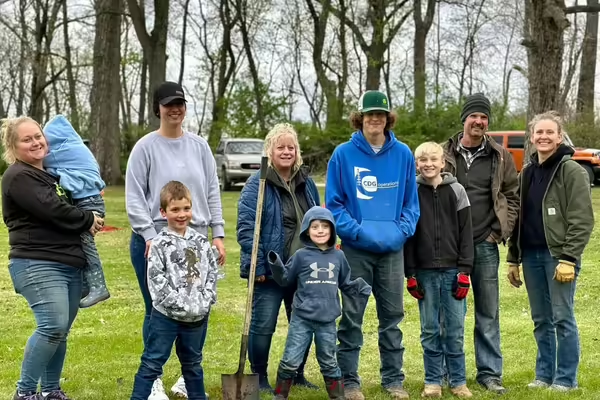
URBANA, Ill. — Carbon neutrality and nutrient runoff are complex issues, but University of Illinois Extension 4-H specialist Curt Sinclair has a simple solution: plant trees.
The 4-H Green Communities Tree Program, initiated in 2021, aims to increase Illinois' tree population, focusing on oak savannas, which are critical to the state’s ecological health.
“We need to become carbon neutral by producing less CO2 gas and finding new ways to absorb and hold these carbon molecules so they don’t get trapped in the atmosphere, which adds to the warming of our planet,” Sinclair said at the program’s launch. “At the same time, we need to reduce stormwater runoff to improve water quality.”
The 2020-2030 Illinois Forest Action Plan, part of the Food, Conservation, and Energy Act of 2008, outlines the benefits of trees for Illinois residents.
“More trees will move us closer to cleaner water, healthier soils, more animals and birds, greater biological diversity, and cleaner air,” Sinclair says. “All these are critical to people’s health and quality of life.”
Sinclair, alongside Illinois 4-H members, has spent the last three years partnering with the Association of Illinois Soil and Water Conservation Districts to increase that number. The effort, 4-H Green Communities Tree Program, is supported by grant funds from the Illinois Forestry Development Council and focuses on action, education, and conservation.
Three years into the initiative, 2,950 oak trees have been planted at 118 sites across 66 counties in Illinois. These efforts have been supported by grant funds from the Illinois Forestry Development Council and have made significant strides towards the goals outlined in the 2020-2030 Illinois Forest Action Plan.
Sinclair and his team are determined to continue this positive trend.
“Our vision is to continue the tree planting program until we have planted at least one oak savanna in every county in the state,” Sinclair says. The AISWCD Forestry Committee, SWCDs, and Illinois Extension 4-H consider this project to be an overwhelming success and plan to seek funding for a similar planting in the spring of 2025.
The 4-H Green Communities Tree Program follows the "learn-by-doing" philosophy of 4-H and is guided by the priorities of the Illinois Forest Action Plan. More trees will move us closer to cleaner water, healthier soils, more animals and birds, greater biological diversity, and cleaner air — all critical to people’s health and quality of life.
The 4-H Green Communities Tree Program is funded by a combination of sources, including corporate and individual donors, which match grant funding.
SOURCE: Curt Sinclair, 4-H youth development specialist, sinclair@illinois.edu
WRITER: Carissa Nelson, media communications manager, 4-H State Office, carissa7@illinois.edu
About Illinois 4-H: Illinois 4-H is the flagship youth development program of University of Illinois Extension and administered through the College of Agriculture, Consumer, and Environmental Sciences. 4-H grows true leaders, youth who are empowered for life today and prepared for a career tomorrow. The hands-on approach in 4-H gives young people guidance, tools, and encouragement, and then puts them in the driver’s seat to make great things happen. Independent research confirms the unparalleled impact of the 4-H experience, demonstrating that young people are four times more likely to contribute to their communities; two times more likely to make healthier choices; two times more likely to be civically active; and two times more likely to participate in STEM programs.
Illinois Extension leads public outreach for University of Illinois by translating research into action plans that allow Illinois families, businesses, and community leaders to solve problems, make informed decisions, and adapt to changes and opportunities. Illinois Extension is part of the University of Illinois Urbana-Champaign College of Agricultural, Consumer and Environmental Sciences.